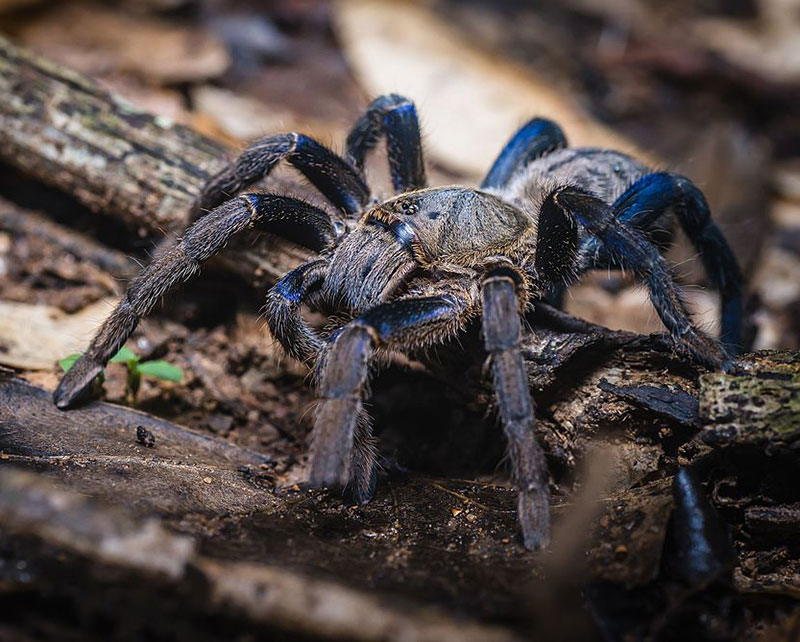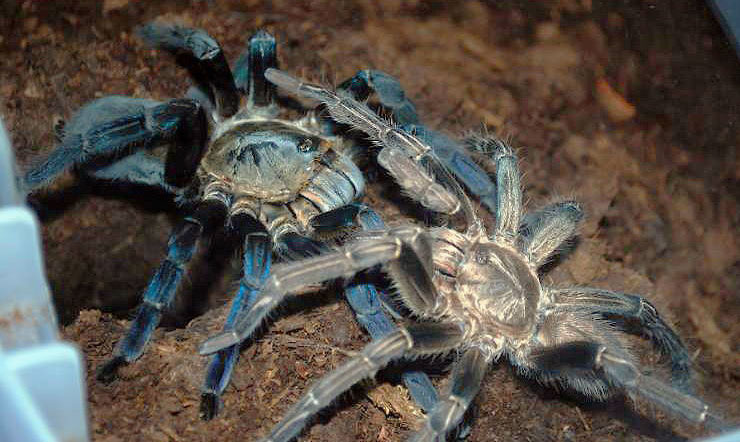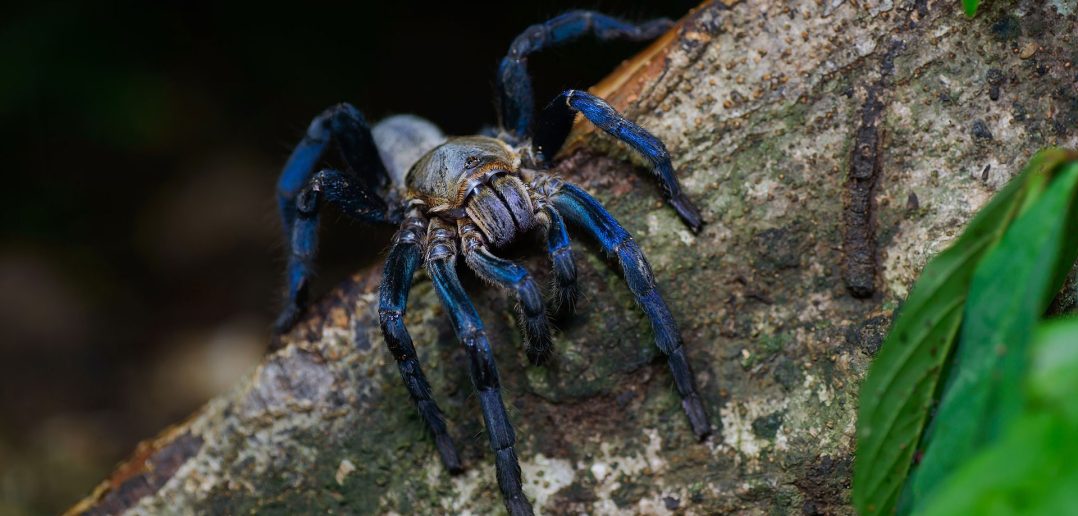Are you into unusual pets like Cobalt Blue Tarantula but don’t know much about them?
Having a tarantula as a pet is not for the faint-hearted. It is not a pet that will be cuddly or visually appealing. A Cobalt Blue Tarantula should only be kept by a professional hobbyist or an award-winning entomologist.
Furthermore, you won’t see them very often because they prefer the darkness and coziness of their burrows.
In any case, they might be fascinating pets to have. It’s intriguing to watch their routines, styles of being, and personalities. However, they are recommended for more experienced pet owners who are skilled and responsible enough to guarantee that these spiders receive the care they require.
Now, if you want to keep a Cobalt blue tarantula as a pet, follow this article to find out their care guide, how to keep them safe, and how to keep yourself safe from them!
An Overview of Cobalt Blue Tarantula
Cobalt Blue Tarantulas get their name from the color of their legs. Their bodies and carapaces are dull in comparison, with a grayish-blue shade. However, this blue is only visible in direct sunlight; otherwise, they appear black or very dark gray. These blue tarantulas have a sparkly metallic aspect reflected off the hairs. Some hairs may seem white or yellow.
Scientific name: Cyriopagopus Lividus, originally described as Haplopelma lividum
Their Basic Care Guide
They are indigenous to Myanmar, but they also originate in Thailand, Vietnam, Laos, Cambodia, and Singapore. They make deep burrows in the earth to live in tropical forests, often only leaving their lairs when it’s time to scavenge for food.
As a result, if you want to keep one as a pet, you must replicate their natural environment. Burrowing requires a warm and humid environment with plenty of substrates. Cobalt Blue Tarantulas are medium-sized and grow very quickly, molting every four to six months. When spiderlings reach sexual maturity, they reveal their gender. Males develop a blue-gray color, while females remain blue.

Their Diet
A Cobalt Blue Tarantula only leaves its burrow to eat, and they are formidable predators. They move quickly and catch prey at the burrow’s outermost edges. They drag it back to their lair and eat it alive after injecting it with their venomous poison.
The Type of Food They Consume
Cobalt Blues Tarantulas eat amphibians, insects such as cockroaches and crickets, mice, and other spiders. Some people label their eating habits as “greedy” because they require a lot of energy to keep up with how quickly they grow. Whatever they eat can’t be bigger than their carapace, and it has to be alive and fresh, not frozen or dead. They can consume up to five large crickets per week.
However, don’t feed your tarantula cockroaches or crickets found in your yard. Purchase them from a pet food supplier to ensure they are free of parasites and mites. However, if a bug gets into your spider’s cage, there’s not much you can do if it’s already feasting on it. Just make sure to toss any leftovers.
Their Lifespan and Health Concerns
Female Cobalt Blue Tarantulas in captivity can have a lifespan of 20 to 25 years. Males live for a shorter period, ranging from five to no more than ten years. They can live in the wild for 30 or 20 years, depending on the species.
Staying hydrated in captivity is the most common health concern for these arachnids. Dehydration is a common cause of death in these animals. Water, humidity, and a moist substrate are therefore essential.
Furthermore, bacterial issues can develop in the substrate from uneaten food if the tank is not cleaned at least once a month. Parasites and mites can infect the tarantula if leftovers are left out for too long. Apart from that, they are rarely afflicted with diseases or other disorders.
Their Behavior
Cobalt Blue Tarantulas spend most of their time in burrows. They’ll come out at night to eat or weave a spider web. They are often quite passive, but they can be very defensive and “touchy.”
When they feel threatened, they will attack anyone or anything. They also have a strong bite that injects a small amount of venom into its victim. Otherwise, they’re fairly calm and docile. They don’t need a lot of exploratory space or other fancy toys to keep them entertained.
How They Molt
They’ll stop eating once they start molting or shedding skin. They will roll onto their backs on the substrate as if dying. If you see something like this, don’t be alarmed; it’s completely normal. Exoskeleton removal can take anywhere from 15 minutes to several hours. Touching or bothering the spider during this process could result in their death.
Their Mating Preferences
When a male is ready to reproduce, he constructs a small silk sack into which he deposits his sperm. He then stores this in his pedipalps and searches for a female to invite to mate. If she is receptive, a dangerous and potentially fatal mating ritual begins.

How to keep Your Cobalt Blue Tarantula Safe
Before acquiring a Cobalt Blue Tarantula as a pet, ensure you understand this animal inside and out. Learn everything you can about it in the wilderness and at home. After that, make sure you get your tarantula from a reliable breeder. You should not get one that has just been caught in the wild.
Then, make sure you have a large enough glass tank with a secure lid to provide a comfortable environment for the tarantula. Other pets, large or small, should be kept away from your tarantula.
Understand that this is not the type of pet you will be able to carry around or interact with. You’ll be able to deal with it if it’s open to the idea, but you should never force it. And that’s how you ensure their safety (and yours).
Is the Cobalt Blue Tarantula Dangerous For Us?
Cobalt Blue Tarantulas are notoriously ill-tempered and will attack if they feel threatened because of their natural defensiveness. Even young spiderlings have been known to ferociously attack when excited or irritated. When they become frustrated, they begin biting, which is quite deadly for small prey. Their venom’s toxicity can, of course, stun and kill small prey, but doesn’t usually post an immediate life-altering threat to humans.
The cobalt blue tarantula bite generally causes irritation, inflammation, rashes, and/or redness in humans – but in extreme cases, though, it can also produce severe muscle cramping and other allergy-related issues that may require medical attention.
Their Temperament and Final Notes
Cobalt Blue Tarantulas are venomous spiders with severe, lethal (to small prey) and painful (to a human) bites. Although these tarantulas are popular, they really are not suitable pets for novices! This species is rare in the wild. However, it is gowning more frequently in captivity.
They are compulsive burrowers and shy creatures but will attack when provoked. Because they lack urticating hairs, they must rely on biting to defend themselves. Though they feel more comfortable in their burrows, these spiders can weave huge webs.
Cobalt Blue Tarantulas can be unusual and tricky animals to pet, but if you study them well, and you’re experienced with such creatures, you should be good to go. I hope this article will help in that regard, good luck!
Featured Image Credit: Rushen, CC BY-SA 2.0, via Wikimedia Commons




